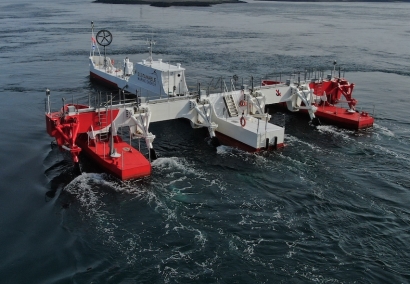During the event, Nova Scotia Minister of Environment and Climate Change Tim Halman 'powered-up' Sustainable Marine's in-stream tidal energy platform, to demonstrate how the technology works to those in attendance, signalling the official start of a new era of clean and predictable energy production for the region.
The Minister and guests were then provided with a tour of the platform where they were able to see the turbines in operation first-hand.
"This marks an incredible milestone in our journey to help communities achieve energy independence and fight climate change by harvesting clean energy from the waters around them," says Jason Hayman, CEO of Sustainable Marine. "We have the potential to revolutionize the Atlantic power grid entirely by tapping into the resource available to us at the Bay of Fundy and we are committed to working collaboratively with our provincial and federal government partners to ensure alignment and remove barriers so we can accelerate the deployment of these technologies and help to transform the electricity system for the Maritimes and deliver the region's net-zero vision. We are very grateful for the generous support provided to this project by NRCan and the Government of Canada to demonstrate that tidal energy can help Canada rapidly reduce GHG emissions." Sustainable Marine's ground-breaking initiative is being supported by the Government of Canada with $28.5 million in funding – representing one of Canada's largest-ever investments in tidal energy. The firm is striving to deliver the world's first floating tidal array at FORCE (Fundy Ocean Research Centre for Energy). This project will be delivered in phases, drawing upon the knowledge gained and lessons learned in Grand Passage.
In the coming months the company will continue to operate the platform at its demonstration site at Grand Passage, gradually building up power production, to further prove the technology and environmental monitoring systems, before commencing deployments in the Minas Passage – renowned as the 'Everest of tidal energy'.
Nova Scotia Environment and Climate Change Minister Timothy Halman said, "The Government of Nova Scotia is committed to addressing climate change and transitioning our province to a clean economy. Clean, renewable energy is our future, and our tides are a key resource as we transition to a net-zero future. I want to commend Sustainable Marine for their work which will bring clean, renewable energy to homes in the province. Through this project, they are helping to lead Nova Scotia forward to a sustainable and prosperous future that will benefit all Nova Scotians and help the health of our environment and our planet."
The Bay of Fundy's huge tidal energy resource contains more than four times the combined flow of every freshwater river in the world, with the potential to generate approximately 2,500 MW of green energy. Sustainable Marine's recent announcement follows more than a decade of research, development and testing, managing the technical challenges associated with operating in highly energetic environments and proving the ultra-low environmental impact of the tidal technology.
Nova Scotia Natural Resources and Renewables Minster Tory Rushton said, "Earlier this year, Sustainable Marine achieved a first in Canadian tidal energy history -- delivering power from a floating platform to Nova Scotia's electricity grid. Now it is poised to launch its commercial tidal operation. This project and others are positioning Nova Scotia as a global player in the tidal energy sector and are creating green technologies, green jobs, a cleaner environment, and a predictable, renewable source of electricity for Nova Scotians."
Nova Scotia has allocated approximately 30 MW of capacity via demonstration permits and berths at FORCE for developers to demonstrate the effectiveness, cost and environmental effects associated with this new form of energy generation.
These demonstration projects provide developers with a pathway to reduce costs on route to commercial projects with regulatory framework already in place. It further aligns with the region's net-zero commitments to accelerate the phase-out of coal-fired electricity by 2030.


